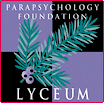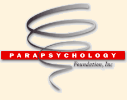 |
 |
| One Down, But More to Go By Hannah Jenkins School of Philosophy University of Tasmania There is an oft-repeated joke relayed to those who have taken on the study of psi phenomena. Parapsychologists, it is said, if they do their job well will do themselves out of work. This is because once psi phenomena are established they will no longer be considered anomalous and parapsychology, defined as the study of such anomalous phenomena, will cease to be and parapsychologists will be required no more. As is often the case, at the heart of a joke lies a kernel of truth. In a recent panel discussion Dean Radin (2000), a scientist and long-time psi researcher, was posed the question: where did he see parapsychology a hundred years from now? He responded that “it won’t be called parapsychology anymore. It’ll be absorbed into mainstream science.” However, parapsychologists need not fear immediately for their positions nor, if that day ever arrives, will they necessarily be out of work. For if psi is ever incorporated into mainstream science the skills and knowledge of the parapsychologist should be in much demand as the challenge of explaining and using psi in the mainstream is undertaken. They might not be called parapsychologists any more, but they may just find it easier to secure funding. When considered in the context of scientific investigation parapsychology poses a series of challenges to the mainstream disciplines. The field of parapsychology has risen admirably to the primary challenge – that of providing an experimental body of evidence which when scrutinized stands up to acceptable methods in mainstream science. Examples of anomalous communication and anomalous action at a distance continue to be collated into case studies of spontaneous occurrences of psi. The ganzfeld experiments and psychokinesis experiments continue to be undertaken, data gathered and statistics analysed. Theoretical experimentation is taking place as the body of evidence grows (Vaitl, 2004). There is informed debate about the evidence from within the parapsychology community and a general consensus that psi effects are real: there is something to explain (Parker, Persson & Haller, 2000). Therefore the current challenge of parapsychology is to develop theory that explains psi. This essay will make a case that philosophy is in a unique position to aid in this endeavor. For despite progress in the empirical arena, theoretical development remains problematic. Many and varied theories have been postulated, but none is significantly comprehensive enough to remain dominant. Dean Radin concedes that this puts parapsychology in a difficult position in relation to science: Science consists of two general areas: there is the act of measurement, which is the empirical side of science, and there is the development of mechanisms, Despite important empirical developments, the theory required to explain the anomalous phenomena remains elusive. Commentators such as Michael Shermer use the lack of theory to argue for skepticism about the phenomena: The deeper reason scientists remain unconvinced of psi is that there is no theory for how psi works. Until psi proponents can elucidate how thoughts generated by neurons in the sender's brain can pass through the skull and into the brain of the receiver, skepticism is the appropriate response. (Shermer, 2003) Theory development that provides an explanation for psi effects is therefore necessary in order to answer the main criticism currently levelled against those who research in this area. However, theory development is hampered by the unresolved anomalous nature of psi and its consequent reception by the mainstream. With a few notable exceptions mainstream scientists continue to resist inclusion of evidence from the field of parapsychology when developing scientific theory. Meanwhile theoretical parapsychologists continue to propose theories in a void outside of the mainstream. The resulting situation is akin to putting together a jigsaw puzzle with some of the pieces missing. The explananda that the body of evidence gives rise to are complex. Explanation will most likely involve developing pertinent theories that tie into recent progress in psychology, cognitive science, neuroscience, biology and physics – to name a few. An interdisciplinary approach is required. But this is where the problem lies because a Catch 22 develops: mainstream scientists will not accept psi until it is explained, but it is unlikely to be explained until it is incorporated into mainstream scientific problem-solving. What to do? Philosophy is the discipline from which the natural sciences originally emerged, but has had a somewhat hands-off approach since the instantiation of the scientific disciplines in their own right. However, the philosophy of science has continued to develop theories about the process and progress of science that can offer clues as to why psi phenomena remain an anathema to mainstream science. These clues can then be used put the anomalous phenomena in context. Although it is recognized that wholesale adoption of psi within the mainstream will not occur until psi theory has been developed to an acceptable extent, at least philosophy can pave a way for initial dialogue between the mainstream and parapsychology. It is hoped that the potential to develop psi theory can then be informed by expert input across the scientific disciplines. Contemporary thought in philosophy of science recognises that, as much as the working scientist might protest, what is considered a body of definitive scientific knowledge during any one era changes with the development of scientific theories over the course of time. Science does not operate in a vacuum and religious, political and social concerns are reflected in the science of the day. Social institutions change as society develops and this impacts on science. Sometimes change is gradual and only affects a small area of scientific concern, but at others it is dramatic and requires substantial rethinking of previously held scientific certainties. Currently science at a macro level is dominated by materialism. Also known as naturalist physicalism the materialist approach is ‘the doctrine that reality consists of nothing but a single all-embracing spatio-temporal system’ (Armstrong, 1980, p. 65). And physicalism is to be understood, as the current prevailing view dictates, that it is through the reduction to physical processes that our understanding of events in the world are to be explained. But psi continues to resist explanation by mechanistic reduction and is therefore seen as either impossible or as a threat to the materialist world view. This situation can be ameliorated by an appeal to an historic understanding of the place that explanation has been sought for psi and the recognition that limits on the scope of science were imposed during the construction of the modern world view. The study of the history of explanation of psi phenomena reveals that in the 1700s, when the foundations of the modern world view were being laid, psi-like events were considered supernatural and required an explanation based on the religious belief system of that era. The mind was thought to be immaterial and was considered physically ineffectual. At the same time the notion that the workings of the physical, tangible natural world were to be explained by the discovery of mechanistic laws. During the course of the ensuing centuries the supernatural/dualist explanatory category was cut from the explanatory scene. The mind became equated with brain and with the rise of behaviorist psychology notions of a soul disappeared altogether. There was no place for psi, which is why it is now considered paranormal (Randall, 1977, pp. 21-55). This situation gives rise to a lurking fear by mainstream scientists that the re-introduction of psi phenomena into mainstream theory development is a way of sneaking these less tangible elements back into the explanatory framework of science or, worse, a reversion back to days of superstition and magical explanatory schemes. The problematic situation is compounded by the perceived threat that psi poses to the physically reductionist rationale of the current materialist world view. However, the search for an explanation for psi does not necessarily dictate a backwards step into a world view dominated by superstition and unworkable concepts. The empirical study of psi is as valid in its use of the scientific method as any other field of scientific inquiry. There is no need to assume that psi theory will be developed in any other way. The challenge is to come to terms with the anomalous nature of the phenomena. This can be perceived as less problematic if the current assumptions stemming from the creation of the modern world view are reconsidered using knowledge from contemporary philosophy of science. The second challenge of parapsychology is then to use philosophical concepts to open the dialogue between parapsychology and the mainstream in order facilitate the development of workable theories to explain psi. Will philosophy rise to the challenge with the same patience and thoughtful determination that parapsychology has to the first? Time will tell. I hope so, because the puzzle will only be solved once all the pieces have been assembled. Armstrong, D. M. (1980). Naturalism, materialism and first philosophy. In The Nature of Mind and Other Essays. St. Lucia: University of Queensland Press. Parker, A., Persson, A., & Haller, A. (2000). Using qualitative ganzfeld research for theory development: Top-down processes in psi-meditation. Journal of the Society for Psychical Research, 64, 65-81. Radin, D. (2000). In Fefferman, L. (Executive Producer) What is parapsychology? Closer to Truth. Show 212. Kuhn Foundation. Accessed online on July 11th, 2006, at http://www.closertotruth.com/topics/mindbrain/212/212transcript.html Randall, J. L. (1977). Parapsychology and the Nature of Life. London: Abacus. Shermer, M. (2003, February). Psychic drift: Why most scientists do not believe in ESP and psi phenomena. Scientific American. Accessed online July 11th, 2006 at http://www.sciam.com/article.cfm?chanID=sa006&articleID=000464CE-BC82-1E1C-8B3B809EC588EEDF&colID=13 Vaitl, D. (Ed.) (2004). Institut für Grenzgebiete der Psychologie und Psychohygiene Biennial Report 2002/2003. Freiburg: Freiburg University. Click here for a biography of Ms. Jenkins. |
 |

|
 www. parapsychology. org |
||